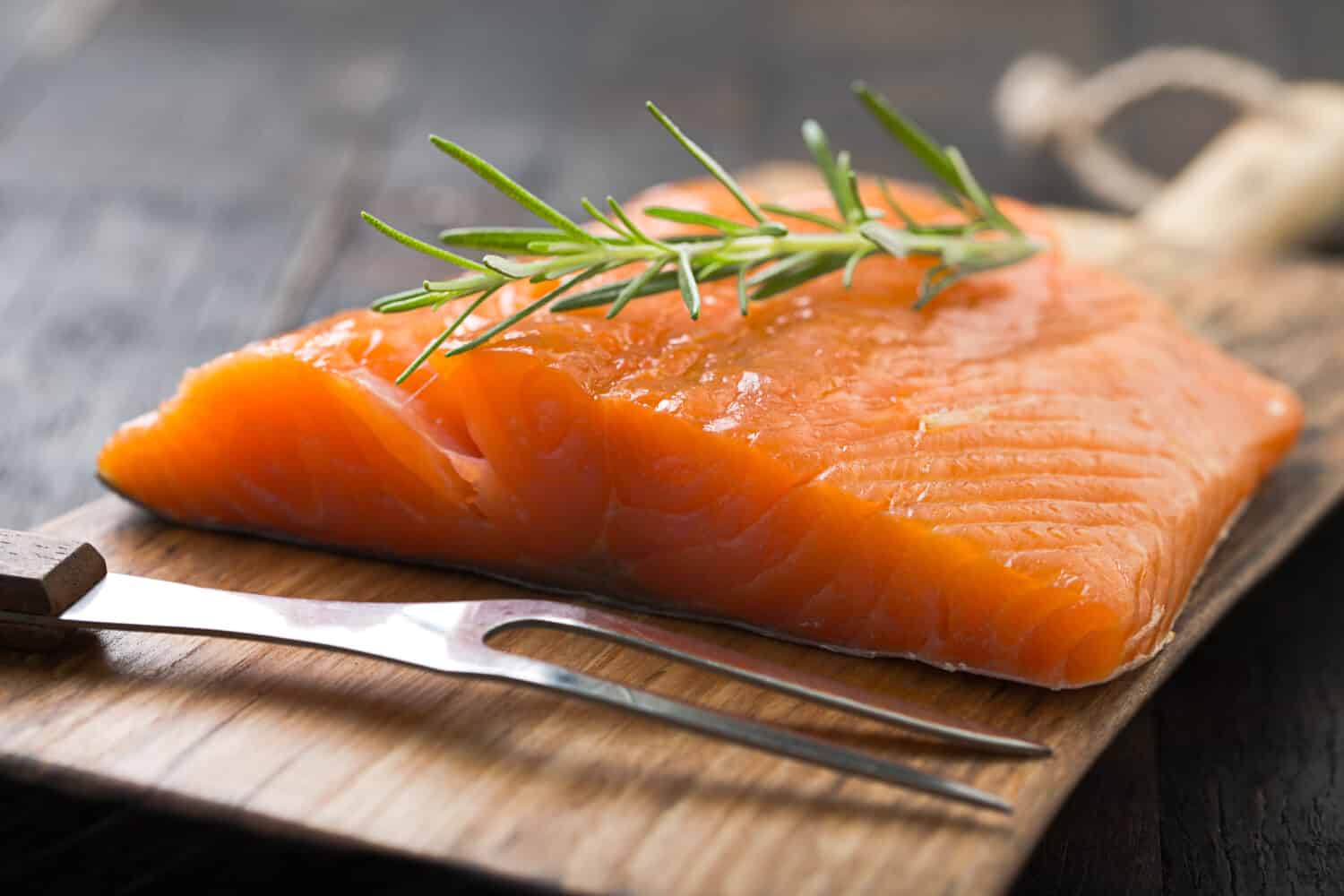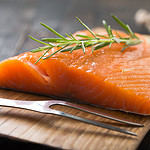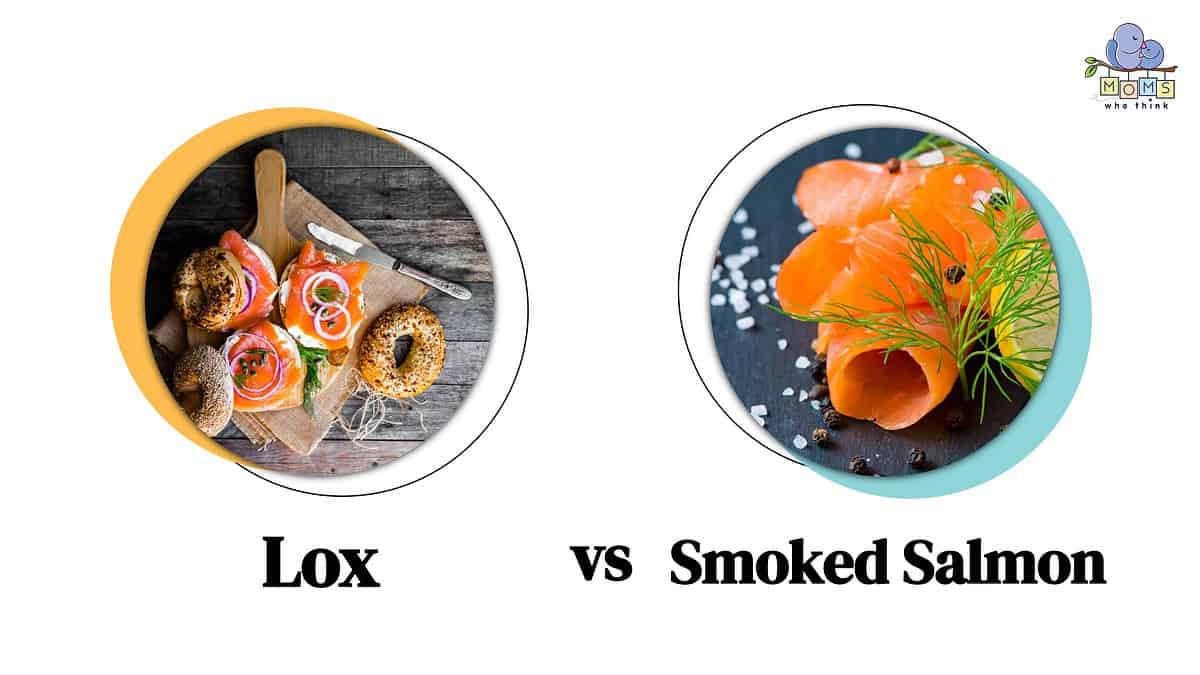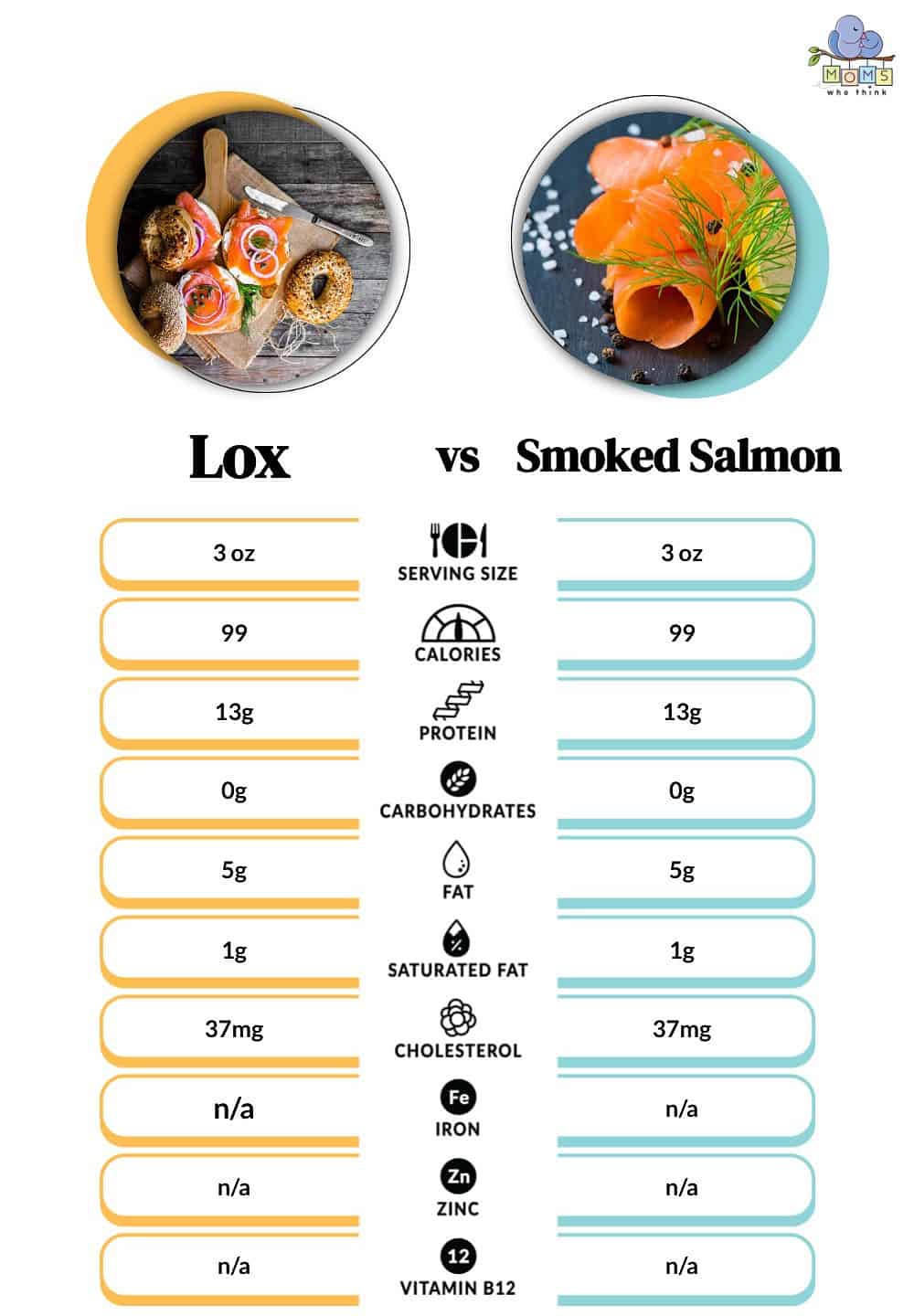Many people often use the terms "Lox" and "smoked salmon" interchangeably. However, there are notable differences between these two types of salmon. We will examine the key differences between Lox and smoked salmon, including the curing process, texture, and flavor. Additionally, we will also take a look at the nutritional profiles of Lox and smoked salmon and see how they compare.
©
What Is Lox? Lox is a salmon fillet that is cured in a brine made of salt, sugar, and other seasonings. Unlike smoked salmon, Lox does not undergo a smoking process, which allows the natural flavors of the fish to come through. The brining process gives the salmon a delicate, smooth texture and a pale pink color. It is popular on bagels with cream cheese, capers, and red onions.
Furthermore, Lox is a traditional Jewish cuisine, usually enjoyed as a breakfast or brunch food. In fact, the word "Lox" comes from the Yiddish word "laks," which means salmon. Although Lox originated in Scandinavia, it was also a popular food among Eastern European Jews, who later introduced it to the United States where it remains a popular delicacy. Moreover, Gravlax is the name for the Scandinavian recipe for Lox, which is when salmon is coated in dill, juniper berries, salt, sugar, and other spices.
A Lox bagel is a classic New York City breakfast food.©Stephanie Frey/Shutterstock.com
What Is Smoked Salmon? Smoked salmon undergoes either curing or brining before smoking. The process of smoking salmon has two methods, namely cold-smoking and hot-smoking. In cold smoking, smoke partially cooks the salmon for a few days. However, in hot-smoking, the salmon cooks completely, like other smoked meats. Smoked salmon has a different taste and texture when compared to Lox, and it is more similar to baked or grilled salmon. People commonly use smoked salmon as a topping for bagels, just like Lox.
Lox vs Smoked Salmon: Key Differences Here's a quick overview of the main differences between Lox and smoked salmon.
Lox Smoked Salmon Appearance Lox is typically a glossy pink color. Smoked salmon is usually a darker shade of pink or orange. Flavor Lox has a mild salty flavor due to the brining. The flavor is less intense than smoked salmon. Smoked salmon has a stronger smoky flavor and smell. Texture Lox is softer and silkier than smoked salmon due to the brining process, which results in a delicate, melt-in-the-mouth texture. The smoking process gives smoked salmon a firmer, flakier texture. Culinary Uses Lox is primarily paired with bagels. A lox bagel is a classic NYC breakfast or brunch staple. Smoked salmon is a versatile food that appears in salads and sandwiches. It is sometimes even an appetizer.
Table comparing the differences between Lox vs. Smoked Salmon Smoked salmon is more versatile, commonly appearing on salads and sandwiches.©JacZia/Shutterstock.com
Lox vs. Smoked Salmon: Nutritional Breakdown The nutritional value of Lox and smoked salmon is quite similar. Both contain high levels of omega-3 fatty acids, which are good for maintaining a healthy heart. Moreover, they are an excellent source of essential proteins, vitamins, and minerals. However, the brining and smoking processes used in preparing these fish can lead to a higher concentration of sodium, which is something to consider if you are trying to limit your salt intake. Here is the nutritional breakdown of Lox and smoked salmon.
©
When eating either Lox or smoked salmon, how you eat it greatly influences how healthy it is for you. For example, since Lox typically appears on bagels with cream cheese, it may sometimes be a less healthy option than eating smoked salmon on a fresh salad.
Nonetheless, both types of salmon are highly nutritious and offer several health benefits, such as protein, essential vitamins like A and B, selenium, and potassium. They also contain antioxidants, and the omega-3 present in both of them is beneficial for the heart and helps improve brain function.
Both Lox and smoked salmon contain omega-3 fatty acids that aid in brain and heart health.©Evan Lorne/Shutterstock.com
In Summary Lox and smoked salmon are often mistaken for each other, but they are distinct types of salmon. Lox is a traditional Jewish dish, commonly served on bagels, made by salt-curing a salmon fillet. It does not undergo a smoking process. On the other hand, salmon is smoked after brining, which results in a flakier fish with a richer taste and texture. Smoked salmon is usually dark pink or orange in appearance. Lox typically has a smoother texture and pale pink color. Smoked salmon is more versatile because it appears in a variety of dishes like salads and sandwiches.
Lox and smoked salmon have almost identical nutritional profiles and offer many health benefits like omega-3, vitamins, and minerals. If you are watching your salt intake, both types of salmon may have higher amounts of sodium than other fish. However, both Lox and smoked salmon are nutritious and delicious options for a well-rounded and nutritious diet.
Recipe Card Print clock clock icon
cutlery cutlery icon
flag flag icon
folder folder icon
instagram instagram icon
pinterest pinterest icon
facebook facebook icon
print print icon
squares squares icon
heart heart icon
heart solid heart solid icon
12 ounces cream cheese, at room temperature1/3 cup sour cream1 Tablespoon 6 3 3 Tablespoons 8 ounces smoked salmon, coarsely chopped3 Tablespoons 1 Tablespoon dried dillfresh ground black pepper fresh dill, for garnish crackers or breadsticks, for serving Cook Mode Prevent your screen from going dark
Puree the cream cheese, sour cream, lemon juice, and Tabasco in a food processor. Add the scallions, capers, salmon, chopped dill, and pepper, and pulse to blend. Garnish with the dill and serve chilled with crackers. window.trCommon={"minRating":6,"ajaxurl":"https:\/\/www.momswhothink.com\/wp-admin\/admin-ajax.php","ratingNonce":"","postId":142475};
window.TastyRecipes = window.TastyRecipes || {}; window.TastyRecipes.smoothScroll = {
init() {
document.addEventListener( 'click', ( e ) => {
let anchor = e.target;
if ( anchor.tagName !== 'A' ) {
anchor = anchor.closest( 'a.tasty-recipes-scrollto' );
} if ( ! anchor || ! anchor.classList.contains( 'tasty-recipes-scrollto' ) ) {
return;
} const elementHref = anchor.getAttribute( 'href' );
if ( ! elementHref ) {
return;
} e.preventDefault();
this.goToSelector( elementHref );
});
},
goToSelector( selector ) {
const element = document.querySelector( selector );
if ( ! element ) {
return;
}
element.scrollIntoView( { behavior: 'smooth' } );
}
}; document.addEventListener(
'DOMContentLoaded',
() => window.TastyRecipes.smoothScroll.init()
); (function(){ var bothEquals = function( d1, d2, D ) {
var ret = 0;
if (d1<=D) {
ret++;
}
if (d2<=D) {
ret++;
}
return ret === 2;
}; var frac =function frac(x,D,mixed){var n1=Math.floor(x),d1=1;var n2=n1+1,d2=1;if(x!==n1){while(bothEquals(d1,d2,D)){var m=(n1+n2)/(d1+d2);if(x===m){if(d1+d2d2){d2=D+1;}else {d1=D+1;}break}else if(xD){d1=d2;n1=n2}if(!mixed){return[0,n1,d1];}var q=Math.floor(n1/d1);return[q,n1-q*d1,d1]};frac.cont=function cont(x,D,mixed){var sgn=x<0?-1:1;var B=x*sgn;var P_2=0,P_1=1,P=0;var Q_2=1,Q_1=0,Q=0;var A=Math.floor(B);while(Q_1<D){A=Math.floor(B);P=A*P_1+P_2;Q=A*Q_1+Q_2;if(B-AD){if(Q_1>D){Q=Q_2;P=P_2}else{Q=Q_1;P=P_1}}if(!mixed){return[0,sgn*P,Q];}var q=Math.floor(sgn*P/Q);return[q,sgn*P-q*Q,Q]}; window.tastyRecipesVulgarFractions = JSON.parse(decodeURIComponent("%7B%22%C2%BC%22%3A%221%2F4%22%2C%22%C2%BD%22%3A%221%2F2%22%2C%22%C2%BE%22%3A%223%2F4%22%2C%22%E2%85%93%22%3A%221%2F3%22%2C%22%E2%85%94%22%3A%222%2F3%22%2C%22%E2%85%95%22%3A%221%2F5%22%2C%22%E2%85%96%22%3A%222%2F5%22%2C%22%E2%85%97%22%3A%223%2F5%22%2C%22%E2%85%98%22%3A%224%2F5%22%2C%22%E2%85%99%22%3A%221%2F6%22%2C%22%E2%85%9A%22%3A%225%2F6%22%2C%22%E2%85%9B%22%3A%221%2F8%22%2C%22%E2%85%9C%22%3A%223%2F8%22%2C%22%E2%85%9D%22%3A%225%2F8%22%2C%22%E2%85%9E%22%3A%227%2F8%22%7D")); window.tastyRecipesFormatAmount = function(amount, el) {
if ( parseFloat( amount ) === parseInt( amount ) ) {
return amount;
}
var roundType = 'frac';
if (typeof el.dataset.amountShouldRound !== 'undefined') {
if ('false' !== el.dataset.amountShouldRound) {
if ( 'number' === el.dataset.amountShouldRound ) {
roundType = 'number';
} else if ('frac' === el.dataset.amountShouldRound) {
roundType = 'frac';
} else if ('vulgar' === el.dataset.amountShouldRound) {
roundType = 'vulgar';
} else {
roundType = 'integer';
}
}
}
if ('number' === roundType) {
amount = Number.parseFloat(amount).toPrecision(2);
} else if ('integer' === roundType) {
amount = Math.round(amount);
} else if ('frac' === roundType || 'vulgar' === roundType) {
var denom = 8;
if (typeof el.dataset.unit !== 'undefined') {
var unit = el.dataset.unit;
if (['cups','cup','c'].includes(unit)) {
denom = 4;
if (0.125 === amount) {
denom = 8;
}
if ("0.1667" === Number.parseFloat( amount ).toPrecision(4)) {
denom = 6;
}
}
if (['tablespoons','tablespoon','tbsp'].includes(unit)) {
denom = 2;
}
if (['teaspoons','teaspoon','tsp'].includes(unit)) {
denom = 8;
}
}
var amountArray = frac.cont( amount, denom, true );
var newAmount = '';
if ( amountArray[1] !== 0 ) {
newAmount = amountArray[1] + '/' + amountArray[2];
if ('vulgar' === roundType) {
Object.keys(window.tastyRecipesVulgarFractions).forEach(function(vulgar) {
if (newAmount === window.tastyRecipesVulgarFractions[vulgar]) {
newAmount = vulgar;
}
});
}
}
if ( newAmount ) {
newAmount = ' ' + newAmount;
}
if ( amountArray[0] ) {
newAmount = amountArray[0] + newAmount;
}
amount = newAmount;
}
return amount;
}; window.tastyRecipesUpdatePrintLink = () => { const printButton = document.querySelector( '.tasty-recipes-print-button' ); if ( ! printButton ) {
return;
} const printURL = new URL( printButton.href );
const searchParams = new URLSearchParams( printURL.search ); const unitButton = document.querySelector( '.tasty-recipes-convert-button-active' );
const scaleButton = document.querySelector( '.tasty-recipes-scale-button-active' ); let unit = '';
let scale = ''; if ( unitButton ) {
unit = unitButton.dataset.unitType;
searchParams.delete('unit');
searchParams.set( 'unit', unit );
} if ( scaleButton ) {
scale = scaleButton.dataset.amount;
searchParams.set( 'scale', scale );
} const paramString = searchParams.toString();
const newURL = '' === paramString ? printURL.href : printURL.origin + printURL.pathname + '?' + paramString;
const printLinks = document.querySelectorAll( '.tasty-recipes-print-link' ); printLinks.forEach( ( el ) => {
el.href = newURL;
}); const printButtons = document.querySelectorAll( '.tasty-recipes-print-button' );
printButtons.forEach( ( el ) => {
el.href = newURL;
});
}; document.addEventListener( 'DOMContentLoaded', () => { if ( ! window.location.href.includes( '/print/' ) ) {
return;
} const searchParams = new URLSearchParams( window.location.search ); const unit = searchParams.get( 'unit' );
const scale = searchParams.get( 'scale' ); if ( unit && ( 'metric' === unit || 'usc' === unit ) ) {
document.querySelector( '.tasty-recipes-convert-button[data-unit-type="' + unit + '"]' ).click();
} if ( scale && Number(scale) > 0 ) {
document.querySelector( '.tasty-recipes-scale-button[data-amount="' + Number(scale) + '"]' ).click();
}
});
}()); (function(){
var buttonClass = 'tasty-recipes-convert-button',
buttonActiveClass = 'tasty-recipes-convert-button-active',
buttons = document.querySelectorAll('.tasty-recipes-convert-button');
if ( ! buttons ) {
return;
}
buttons.forEach(function(button){
button.addEventListener('click', function(event){
event.preventDefault();
var recipe = event.target.closest('.tasty-recipes');
if ( ! recipe ) {
return;
}
var otherButtons = recipe.querySelectorAll('.' + buttonClass);
otherButtons.forEach(function(bt){
bt.classList.remove(buttonActiveClass);
});
button.classList.add(buttonActiveClass);
var unitType = button.dataset.unitType;
var dataset = 'nf' + unitType.charAt(0).toUpperCase() + unitType.slice(1);
var convertables = recipe.querySelectorAll('span[data-nf-original]');
convertables.forEach(function(convertable){
if (typeof convertable.dataset.amountOriginalType === 'undefined'
&& 'usc' === convertable.dataset.nfOriginal) {
if (-1 !== convertable.innerText.indexOf('/')) {
convertable.dataset.amountOriginalType = 'frac';
}
if (-1 !== convertable.innerText.indexOf('.')) {
convertable.dataset.amountOriginalType = 'number';
}
Object.keys(window.tastyRecipesVulgarFractions).forEach(function(vulgar) {
if (-1 !== convertable.innerText.indexOf(vulgar)) {
convertable.dataset.amountOriginalType = 'vulgar';
}
});
}
convertable.innerText = convertable.dataset[dataset];
if (typeof convertable.dataset.unit !== 'undefined') {
convertable.dataset.unit = convertable.dataset[dataset + 'Unit'];
}
if (typeof convertable.dataset.amount !== 'undefined') {
convertable.dataset.amount = convertable.dataset[dataset];
if ('metric' === unitType) {
convertable.dataset.amountShouldRound = parseInt(convertable.dataset.amount) >= 10 ? 'integer' : 'number';
} else if (typeof convertable.dataset.amountOriginalType !== 'undefined') {
convertable.dataset.amountShouldRound = convertable.dataset.amountOriginalType;
} else {
convertable.dataset.amountShouldRound = false;
}
convertable.innerText = window.tastyRecipesFormatAmount(convertable.dataset[dataset], convertable);
}
if (convertable.classList.contains('nutrifox-unit')) {
if ('gram' === convertable.dataset[dataset]) {
convertable.innerText = 'grams';
}
}
}); document.querySelectorAll('.tasty-recipes-scale-button-active').forEach(function(scaleButton){
scaleButton.click();
}); window.tastyRecipesUpdatePrintLink();
});
});
}()); (function(){
var buttonClass = 'tasty-recipes-scale-button',
buttonActiveClass = 'tasty-recipes-scale-button-active',
buttons = document.querySelectorAll('.tasty-recipes-scale-button');
if ( ! buttons ) {
return;
} buttons.forEach(function(button){
button.addEventListener('click', function(event){
event.preventDefault();
var recipe = event.target.closest('.tasty-recipes');
if ( ! recipe ) {
return;
}
var otherButtons = recipe.querySelectorAll('.' + buttonClass);
otherButtons.forEach(function(bt){
bt.classList.remove(buttonActiveClass);
});
button.classList.add(buttonActiveClass); var scalables = recipe.querySelectorAll('span[data-amount]');
var buttonAmount = parseFloat( button.dataset.amount );
scalables.forEach(function(scalable){
if (typeof scalable.dataset.amountOriginalType === 'undefined'
&& typeof scalable.dataset.nfOriginal === 'undefined') {
if (-1 !== scalable.innerText.indexOf('/')) {
scalable.dataset.amountOriginalType = 'frac';
}
if (-1 !== scalable.innerText.indexOf('.')) {
scalable.dataset.amountOriginalType = 'number';
}
Object.keys(window.tastyRecipesVulgarFractions).forEach(function(vulgar) {
if (-1 !== scalable.innerText.indexOf(vulgar)) {
scalable.dataset.amountOriginalType = 'vulgar';
}
});
if (typeof scalable.dataset.amountOriginalType !== 'undefined') {
scalable.dataset.amountShouldRound = scalable.dataset.amountOriginalType;
}
}
var amount = parseFloat( scalable.dataset.amount ) * buttonAmount;
amount = window.tastyRecipesFormatAmount(amount, scalable);
if ( typeof scalable.dataset.unit !== 'undefined' ) {
if ( ! scalable.classList.contains('nutrifox-quantity') ) {
if ( ! scalable.classList.contains('nutrifox-second-quantity') ) {
amount += ' ' + scalable.dataset.unit;
}
}
}
scalable.innerText = amount;
}); var nonNumerics = recipe.querySelectorAll('[data-has-non-numeric-amount]');
nonNumerics.forEach(function(nonNumeric){
var indicator = nonNumeric.querySelector('span[data-non-numeric-label]');
if ( indicator ) {
nonNumeric.removeChild(indicator);
}
if ( 1 !== buttonAmount ) {
indicator = document.createElement('span');
indicator.setAttribute('data-non-numeric-label', true);
var text = document.createTextNode(' (x' + buttonAmount + ')');
indicator.appendChild(text);
nonNumeric.appendChild(indicator);
}
}); window.tastyRecipesUpdatePrintLink();
});
});
}()); window.TastyRecipes = window.TastyRecipes || {};
window.TastyRecipes.cookMode = {
wakeLockApi: false,
wakeLock: false,
cookModeSelector: '.tasty-recipes-cook-mode',
init() {
if ("wakeLock" in navigator && "request" in navigator.wakeLock) {
this.wakeLockApi = navigator.wakeLock;
} const cookModes = document.querySelectorAll(this.cookModeSelector); if (cookModes.length > 0) {
for (const cookMode of cookModes) {
if (this.wakeLockApi) {
cookMode.querySelector('input[type="checkbox"]').addEventListener("change", event => {
this.checkboxChange(event.target);
}, false);
} else {
cookMode.style.display = "none";
}
}
}
},
checkboxChange(checkbox) {
if (checkbox.checked) {
this.lock();
} else {
this.unlock();
}
},
setCheckboxesState(state) {
const checkboxes = document.querySelectorAll(this.cookModeSelector + ' input[type="checkbox"]');
for (const checkbox of checkboxes) {
checkbox.checked = state;
}
},
async lock() {
try {
this.wakeLock = await this.wakeLockApi.request("screen");
this.wakeLock.addEventListener("release", () => {
this.wakeLock = false;
this.setCheckboxesState(false);
});
this.setCheckboxesState(true);
} catch (error) {
this.setCheckboxesState(false);
}
},
unlock() {
if (this.wakeLock) {
this.wakeLock.release();
this.wakeLock = false;
}
this.setCheckboxesState(false);
}
}; (function(callback) {
if (document.readyState !== "loading") {
callback();
} else {
document.addEventListener("DOMContentLoaded", callback);
}
})(() => {
window.TastyRecipes.cookMode.init();
}); window.TastyRecipes = window.TastyRecipes || {}; window.TastyRecipes.staticTooltip = {
element: null,
tooltipElement: null,
deleting: false,
init( element ) {
if ( this.deleting ) {
return;
}
this.element = element;
this.buildElements();
},
destroy() {
if ( ! this.tooltipElement || this.deleting ) {
return;
} this.deleting = true;
this.tooltipElement.classList.remove( 'opened' ); setTimeout( () => {
this.tooltipElement.remove();
this.deleting = false;
}, 500 );
},
buildElements() {
const tooltipElement = document.createElement( 'div' );
tooltipElement.classList.add( 'tasty-recipes-static-tooltip');
tooltipElement.setAttribute( 'id', 'tasty-recipes-tooltip' ); const currentTooltipElement = document.getElementById( 'tasty-recipes-tooltip' );
if ( currentTooltipElement ) {
document.body.replaceChild( tooltipElement, currentTooltipElement );
} else {
document.body.appendChild( tooltipElement );
} this.tooltipElement = document.getElementById( 'tasty-recipes-tooltip' );
},
show() {
if ( ! this.tooltipElement ) {
return;
} const tooltipTop = this.element.getBoundingClientRect().top
+ window.scrollY
- 10 // 10px offset.
- this.tooltipElement.getBoundingClientRect().height;
const tooltipLeft = this.element.getBoundingClientRect().left
- ( this.tooltipElement.getBoundingClientRect().width / 2 )
+ ( this.element.getBoundingClientRect().width / 2 ) - 1;
const posLeft = Math.max( 10, tooltipLeft );
this.maybeRemoveTail( posLeft !== tooltipLeft ); this.tooltipElement.setAttribute( 'style', 'top:' + tooltipTop + 'px;left:' + posLeft + 'px;' );
this.tooltipElement.classList.add( 'opened' ); },
maybeRemoveTail( removeTail ) {
if ( removeTail ) {
this.tooltipElement.classList.add( 'tr-hide-tail' );
} else {
this.tooltipElement.classList.remove( 'tr-hide-tail' );
}
},
changeMessage( message ) {
if ( ! this.tooltipElement ) {
return;
}
this.tooltipElement.innerHTML = message;
}
}; window.TastyRecipes.ajax = {
sendPostRequest( url, data, success, failure ) {
const xhr = new XMLHttpRequest();
xhr.open( 'POST', url, true );
xhr.send( this.preparePostData( data ) ); xhr.onreadystatechange = () => {
if ( 4 !== xhr.readyState ) {
return;
}
if ( xhr.status === 200 ) {
success( JSON.parse( xhr.responseText ) );
return;
} failure( xhr );
}; xhr.onerror = () => {
failure( xhr );
};
},
preparePostData( data ) {
const formData = new FormData(); for ( const key in data ) {
formData.append( key, data[key] );
}
return formData;
},
}; window.TastyRecipes.ratings = {
defaultRating: 0,
currentRatingPercentage: 100,
savingRating: false,
init( minRating ) {
this.minRating = minRating; this.formWatchRating();
this.closeTooltipWhenClickOutside();
this.addBodyClassBasedOnSelectedRating();
this.backwardCompFormRatingPosition();
},
formWatchRating() {
const ratings = document.querySelectorAll('.tasty-recipes-no-ratings-buttons [data-rating]');
if ( ratings.length {
event.preventDefault();
this.defaultRating = event.target.closest( '.checked' ).dataset.rating;
this.setCheckedStar( event.target );
this.maybeSendRating( this.defaultRating, event.target );
this.setRatingInForm( this.defaultRating );
} );
}
},
closeTooltipWhenClickOutside() {
window.addEventListener( 'click', e => {
// Bailout (don't remove the tooltip) when the clicked element is a rating star, or it's the tooltip itself.
if ( e.target.closest( '.tasty-recipes-rating' ) || e.target.classList.contains( 'tasty-recipes-static-tooltip' ) ) {
return;
} window.TastyRecipes.staticTooltip.destroy();
} );
},
setRatingInForm( rating ) {
const ratingInput = document.querySelector( '#respond .tasty-recipes-rating[value="' + rating + '"]' );
if ( ! ratingInput ) {
return;
}
ratingInput.click();
},
addBodyClassBasedOnSelectedRating() {
const ratingInputs = document.querySelectorAll( 'input.tasty-recipes-rating' );
if ( ! ratingInputs ) {
return;
}
for ( const ratingInput of ratingInputs ) {
ratingInput.addEventListener( 'click', currentEvent => {
const selectedRating = currentEvent.target.getAttribute( 'value' );
this.handleBodyClassByRating( selectedRating );
this.toggleCommentTextareaRequired( selectedRating );
} );
}
},
handleBodyClassByRating( rating ) {
if ( rating < this.minRating ) {
document.body.classList.remove( 'tasty-recipes-selected-minimum-rating' );
return;
}
document.body.classList.add( 'tasty-recipes-selected-minimum-rating' );
},
toggleCommentTextareaRequired( rating ) {
const commentTextarea = document.getElementById( 'comment' );
if ( ! commentTextarea ) {
return;
} if ( rating {
window.TastyRecipes.staticTooltip.changeMessage( response.data.message );
window.TastyRecipes.staticTooltip.show();
this.updateAverageText( response.data, recipeCardElement );
this.maybeFillCommentForm( response.data ); // Hide the tooltip after 5 seconds.
setTimeout( () => {
this.maybeResetTooltip( recipeCardElement, response.data, rating );
}, 5000 );
},
() => {
this.resetTooltip( recipeCardElement );
}
);
},
updateAverageText( data, recipeCardElement ) {
if ( ! data.average ) {
return;
}
this.setRatingPercent( data ); if ( ! data.count ) {
return;
} const quickLink = document.querySelector( '.tasty-recipes-rating-link' );
if ( quickLink ) {
this.setTextInContainer( quickLink, data );
this.setPartialStar( quickLink );
} const cardStars = recipeCardElement.querySelector( '.tasty-recipes-ratings-buttons' );
cardStars.dataset.trDefaultRating = data.average;
this.setTextInContainer( recipeCardElement.querySelector( '.tasty-recipes-rating' ), data );
},
setTextInContainer( container, data ) {
if ( ! container ) {
return;
} if ( data.label ) {
const ratingLabelElement = container.querySelector( '.rating-label' );
if ( ratingLabelElement ) {
ratingLabelElement.innerHTML = data.label;
}
return;
} const averageElement = container.querySelector( '.average' );
if ( averageElement ) {
averageElement.textContent = data.average;
} const countElement = container.querySelector( '.count' );
if ( countElement ) {
countElement.textContent = data.count;
}
},
setPartialStar( container ) {
const highestStar = container.querySelector( '[data-rating="' + Math.ceil( this.defaultRating ) + '"]' );
if ( highestStar ) {
highestStar.dataset.trClip = this.currentRatingPercentage;
}
},
setRatingPercent( data ) {
this.defaultRating = data.average.toFixed( 1 );
const parts = data.average.toFixed( 2 ).toString().split( '.' );
this.currentRatingPercentage = parts[1] ? parts[1] : 100;
if ( this.currentRatingPercentage === '00' ) {
this.currentRatingPercentage = 100;
}
},
setCheckedStar( target ) {
const cardRatingContainer = target.closest( '.tasty-recipes-ratings-buttons' );
const selectedRatingElement = cardRatingContainer.querySelector( '[data-tr-checked]' );
if ( selectedRatingElement ) {
delete selectedRatingElement.dataset.trChecked;
} const thisStar = target.closest( '.tasty-recipes-rating' );
thisStar.dataset.trChecked = 1;
thisStar.querySelector( '[data-tr-clip]' ).dataset.trClip = 100;
},
maybeFillCommentForm( data ) {
if ( ! data.comment || ! data.comment.content ) {
return;
} const commentForm = document.querySelector( '#commentform' );
if ( ! commentForm ) {
return;
} const commentBox = commentForm.querySelector( '[name=comment]' );
if ( ! commentBox || commentBox.value ) {
return;
} // Add comment details for editing.
commentBox.innerHTML = data.comment.content;
if ( data.comment.name ) {
commentForm.querySelector( '[name=author]' ).value = data.comment.name;
commentForm.querySelector( '[name=email]' ).value = data.comment.email;
}
},
maybeResetTooltip( recipeCardElement, data, rating ) {
if ( this.savingRating === rating ) {
this.resetTooltip( recipeCardElement, data );
}
},
resetTooltip( recipeCardElement, data ) {
window.TastyRecipes.staticTooltip.destroy();
this.savingRating = false; // Reset the default rating.
const cardRatingContainer = recipeCardElement.querySelector( '.tasty-recipes-ratings-buttons' );
if ( cardRatingContainer ) {
this.defaultRating = ( data && data.average ) ? data.average.toFixed(1) : cardRatingContainer.dataset.trDefaultRating;
cardRatingContainer.dataset.trDefaultRating = this.defaultRating; this.resetSelectedStar( cardRatingContainer, data );
}
},
resetSelectedStar( cardRatingContainer ) {
const selectedRatingElement = cardRatingContainer.querySelector( '[data-rating="' + Math.ceil( this.defaultRating ) + '"]' );
if ( selectedRatingElement ) {
selectedRatingElement.querySelector( '[data-tr-clip]' ).dataset.trClip = this.currentRatingPercentage;
selectedRatingElement.parentNode.dataset.trChecked = 1;
} const previousSelectedElement= cardRatingContainer.querySelector( '[data-tr-checked]' );
if ( previousSelectedElement ) {
const currentSelectedRating = previousSelectedElement.querySelector('[data-rating]');
if ( currentSelectedRating !== selectedRatingElement ) {
delete previousSelectedElement.dataset.trChecked;
}
}
},
backwardCompFormRatingPosition() {
const ratingsButtons = document.querySelector( '#respond .tasty-recipes-ratings-buttons, #tasty-recipes-comment-rating .tasty-recipes-ratings-buttons' );
if ( ! ratingsButtons ) {
return;
}
const ratingsButtonsStyles = window.getComputedStyle(ratingsButtons);
if ( ! ratingsButtonsStyles.display.includes( 'flex' ) ) {
ratingsButtons.style.direction = 'rtl';
} if ( typeof tastyRecipesRating !== 'undefined' ) {
// Select the rating that was previously selected in admin.
ratingsButtons.querySelector( '.tasty-recipes-rating[value="' + tastyRecipesRating + '"]' ).checked = true;
} const ratingSpans = ratingsButtons.querySelectorAll( '.tasty-recipes-rating' );
for (const ratingSpan of ratingSpans) {
ratingSpan.addEventListener( 'click', event => {
if ( ratingSpan === event.target ) {
return;
}
ratingSpan.previousElementSibling.click();
} );
}
}
}; (function(callback) {
if (document.readyState !== "loading") {
callback();
} else {
window.addEventListener( 'load', callback );
}
})(() => {
window.TastyRecipes.ratings.init( window.trCommon ? window.trCommon.minRating : 4 );
});












 (No Ratings Yet)
(No Ratings Yet)![]()